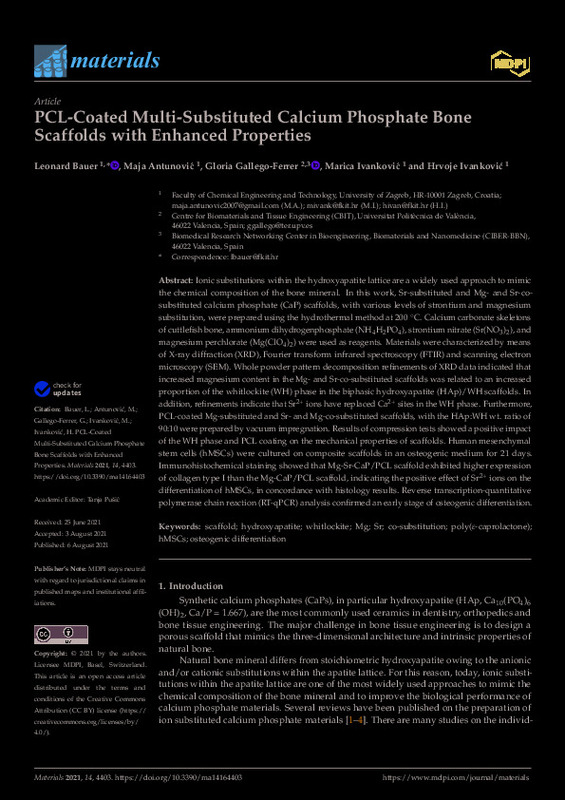Bauer, L.; Antunovic, M.; Gallego-Ferrer, G.; Ivankovic, M.; Ivankovic, H. (2021). PCL-Coated Multi-Substituted Calcium Phosphate Bone Scaffolds with Enhanced Properties. Materials. 14(16):1-19. https://doi.org/10.3390/ma14164403
Por favor, use este identificador para citar o enlazar este ítem: http://hdl.handle.net/10251/186997
|
Título:
|
PCL-Coated Multi-Substituted Calcium Phosphate Bone Scaffolds with Enhanced Properties
|
|
Autor:
|
Bauer, Leonard
Antunovic, Maja

 Gallego-Ferrer, Gloria
Ivankovic, Marica
Ivankovic, Hrvoje
Gallego-Ferrer, Gloria
Ivankovic, Marica
Ivankovic, Hrvoje
|
|
Entidad UPV:
|
Universitat Politècnica de València. Departamento de Termodinámica Aplicada - Departament de Termodinàmica Aplicada
|
|
Fecha difusión:
|
|
|
Resumen:
|
[EN] Ionic substitutions within the hydroxyapatite lattice are a widely used approach to mimic the chemical composition of the bone mineral. In this work, Sr-substituted and Mg- and Sr-co-substituted calcium phosphate (CaP) ...[+]
[EN] Ionic substitutions within the hydroxyapatite lattice are a widely used approach to mimic the chemical composition of the bone mineral. In this work, Sr-substituted and Mg- and Sr-co-substituted calcium phosphate (CaP) scaffolds, with various levels of strontium and magnesium substitution, were prepared using the hydrothermal method at 200 degrees C. Calcium carbonate skeletons of cuttlefish bone, ammonium dihydrogenphosphate (NH4H2PO4), strontium nitrate (Sr(NO3)(2)), and magnesium perchlorate (Mg(ClO4)(2)) were used as reagents. Materials were characterized by means of X-ray diffraction (XRD), Fourier transform infrared spectroscopy (FTIR) and scanning electron microscopy (SEM). Whole powder pattern decomposition refinements of XRD data indicated that increased magnesium content in the Mg- and Sr-co-substituted scaffolds was related to an increased proportion of the whitlockite (WH) phase in the biphasic hydroxyapatite (HAp)/WH scaffolds. In addition, refinements indicate that Sr2+ ions have replaced Ca2+ sites in the WH phase. Furthermore, PCL-coated Mg-substituted and Sr- and Mg-co-substituted scaffolds, with the HAp:WH wt. ratio of 90:10 were prepared by vacuum impregnation. Results of compression tests showed a positive impact of the WH phase and PCL coating on the mechanical properties of scaffolds. Human mesenchymal stem cells (hMSCs) were cultured on composite scaffolds in an osteogenic medium for 21 days. Immunohistochemical staining showed that Mg-Sr-CaP/PCL scaffold exhibited higher expression of collagen type I than the Mg-CaP/PCL scaffold, indicating the positive effect of Sr2+ ions on the differentiation of hMSCs, in concordance with histology results. Reverse transcription-quantitative polymerase chain reaction (RT-qPCR) analysis confirmed an early stage of osteogenic differentiation.
[-]
|
|
Palabras clave:
|
Scaffold
,
Hydroxyapatite
,
Whitlockite
,
Mg
,
Sr
,
Co-substitution,poly(epsilon-caprolactone)
,
MSCs
,
Osteogenic differentiation
|
|
Derechos de uso:
|
Reconocimiento (by)
|
|
Fuente:
|
Materials. (eissn:
1996-1944
)
|
|
DOI:
|
10.3390/ma14164403
|
|
Editorial:
|
MDPI AG
|
|
Versión del editor:
|
https://doi.org/10.3390/ma14164403
|
|
Código del Proyecto:
|
info:eu-repo/grantAgreement/AEI/Plan Estatal de Investigación Científica y Técnica y de Innovación 2017-2020/PID2019-106000RB-C21/ES/HIDROGELES BIOMIMETICOS IMPRIMIBLES CON PRESENTACION DE FACTORES DE CRECIMIENTO EFICIENTE PARA ESTUDIOS DE HEPATOTOXICIDAD DE ALTO RENDIMIENTO/
info:eu-repo/grantAgreement/ESIF//KK.01.1.1.07.0014/
info:eu-repo/grantAgreement/HRZZ//IP-2014-09-3752/
|
|
Agradecimientos:
|
This research was funded by the Croatian Science Foundation (project IP-2014-09-3752) and the European Structural and Investments Funds (grant KK.01.1.1.07.0014.).
The authors thank Inga Urli, Faculty of Science, University ...[+]
This research was funded by the Croatian Science Foundation (project IP-2014-09-3752) and the European Structural and Investments Funds (grant KK.01.1.1.07.0014.).
The authors thank Inga Urli, Faculty of Science, University of Zagreb for providing Hek293 and hMSC cells. Compression experiments were carried out at the Centre for Biomaterials and Tissue Engineering (CBIT), Universitat Politecnica de Valencia, Valencia, Spain under the PID2019-106000RB-C21/AEI/10.13039/501100011033 project. The authors would like to thank Jorge Mas-Estelles for his generous assistance.
[-]
|
|
Tipo:
|
Artículo
|









